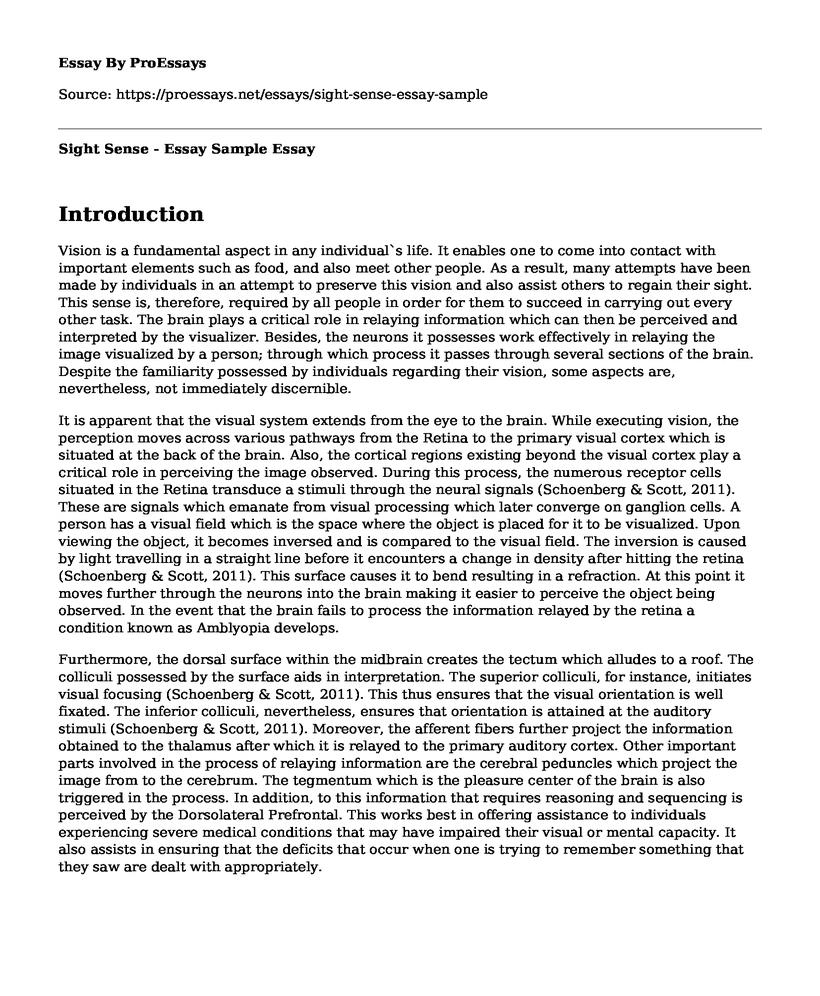Introduction
Vision is a fundamental aspect in any individual`s life. It enables one to come into contact with important elements such as food, and also meet other people. As a result, many attempts have been made by individuals in an attempt to preserve this vision and also assist others to regain their sight. This sense is, therefore, required by all people in order for them to succeed in carrying out every other task. The brain plays a critical role in relaying information which can then be perceived and interpreted by the visualizer. Besides, the neurons it possesses work effectively in relaying the image visualized by a person; through which process it passes through several sections of the brain. Despite the familiarity possessed by individuals regarding their vision, some aspects are, nevertheless, not immediately discernible.
It is apparent that the visual system extends from the eye to the brain. While executing vision, the perception moves across various pathways from the Retina to the primary visual cortex which is situated at the back of the brain. Also, the cortical regions existing beyond the visual cortex play a critical role in perceiving the image observed. During this process, the numerous receptor cells situated in the Retina transduce a stimuli through the neural signals (Schoenberg & Scott, 2011). These are signals which emanate from visual processing which later converge on ganglion cells. A person has a visual field which is the space where the object is placed for it to be visualized. Upon viewing the object, it becomes inversed and is compared to the visual field. The inversion is caused by light travelling in a straight line before it encounters a change in density after hitting the retina (Schoenberg & Scott, 2011). This surface causes it to bend resulting in a refraction. At this point it moves further through the neurons into the brain making it easier to perceive the object being observed. In the event that the brain fails to process the information relayed by the retina a condition known as Amblyopia develops.
Furthermore, the dorsal surface within the midbrain creates the tectum which alludes to a roof. The colliculi possessed by the surface aids in interpretation. The superior colliculi, for instance, initiates visual focusing (Schoenberg & Scott, 2011). This thus ensures that the visual orientation is well fixated. The inferior colliculi, nevertheless, ensures that orientation is attained at the auditory stimuli (Schoenberg & Scott, 2011). Moreover, the afferent fibers further project the information obtained to the thalamus after which it is relayed to the primary auditory cortex. Other important parts involved in the process of relaying information are the cerebral peduncles which project the image from to the cerebrum. The tegmentum which is the pleasure center of the brain is also triggered in the process. In addition, to this information that requires reasoning and sequencing is perceived by the Dorsolateral Prefrontal. This works best in offering assistance to individuals experiencing severe medical conditions that may have impaired their visual or mental capacity. It also assists in ensuring that the deficits that occur when one is trying to remember something that they saw are dealt with appropriately.
Conclusion
To sum it all up, the familiarity possessed by individuals regarding their vision is not enough since some aspects are, nevertheless, not immediately discernible. It is, nevertheless, important to note that once an object is visualized, the perception moves through the eye via the cortex. It is then transmitted through neurons into the brain until it reaches the primary visual cortex. Also, light moving into the eye aids in the visualization process. It, however, moves in a straight line until it hits the cortex where it becomes refracted in order for it to move through the eye. The entire process is fundamental since it enables one to acquire critical information regarding why things appear the way they do.
References
Schoenberg, M. R., & Scott, J. G. (2011). The little black book of neuropsychology: a syndrome-based approach (pp. 1-37). New York: Springer.
Cite this page
Sight Sense - Essay Sample. (2022, Dec 19). Retrieved from https://proessays.net/essays/sight-sense-essay-sample
If you are the original author of this essay and no longer wish to have it published on the ProEssays website, please click below to request its removal:
- Can Apes Learn Language?
- Essay Example on the Human Genome Project (HGP)
- Research Paper on Parts of the Digestive System
- Effects of Ionizing Radiation on Deoxyribonucleic Acid (DNA)
- Ethical Limits of Genetic Engineering
- Preserving Human Dignity: Human Reproductive Cloning
- Essay on the Interconnectedness of Animal Diseases: An Analysis of Quammen's Spillover







